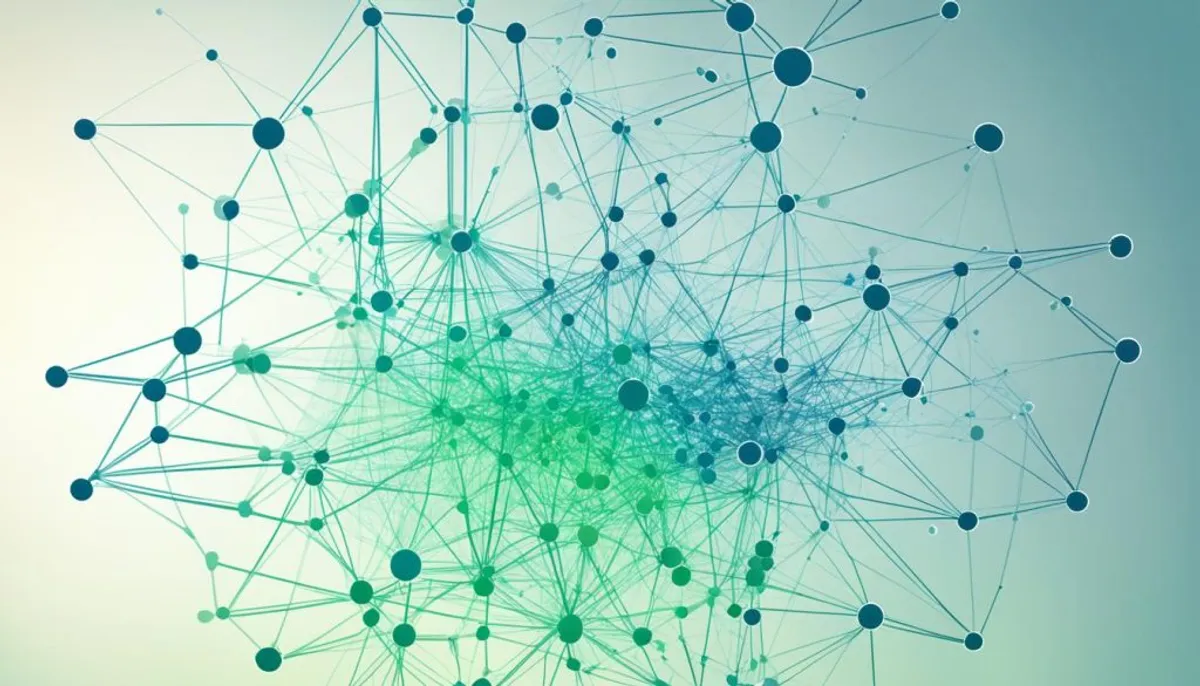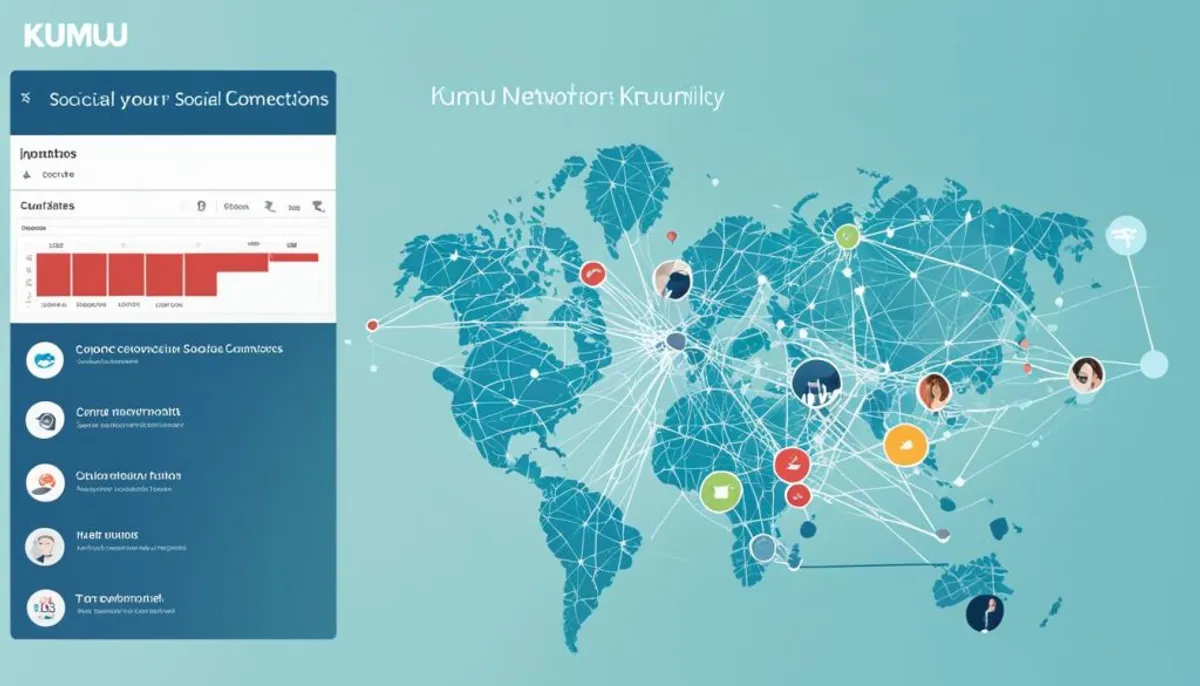In today’s digital world, our social connections are very powerful. They can give us valuable insights to improve our online presence and influence. The social network calculator is a tool that helps you understand your connections better.
This article will show you how social network calculators can change things. We’ll cover the basics of analyzing social networks, how to collect data, and using tools like Kumu for visualization. By the end, you’ll know how to use your social network to succeed in your goals.

If you’re an entrepreneur, a content creator, or a professional looking to grow, the social network calculator is key. It helps you see your real influence and find important people in your network. Get ready to see your social connections in a new way.
Introduction to Social Network Analysis
Social network analysis (SNA) is a way to study the complex connections in social networks. It looks at the web of relationships between people or groups. By seeing networks as a mix of nodes (people or groups) and edges (their connections), SNA helps us understand how information moves and how groups work together.
What is a Social Network?
A social network is a structure that helps people or groups talk and interact. These networks can be about friends, work, or online communities. They are key in how we share info, connect, and affect each other.
Importance of Social Network Analysis
- Understand communication patterns and information flow within a network
- Identify key influencers, opinion leaders, and central figures in a social structure
- Analyze the strength and dynamics of relationships between network members
- Detect emerging trends, patterns, and potential opportunities or challenges
- Optimize the structure and function of organizations, communities, and other social systems
Using social network analysis, experts can better understand our complex social world. They can see how people connect, share info, and influence each other. This transformative mindset shift helps tackle many challenges, like making groups work better or tracking disease spread.
| Key Benefit | Description |
|---|---|
| Identify Influencers | Pinpoint the most central and influential actors within a social network |
| Analyze Relationships | Understand the strength and dynamics of connections between network members |
| Detect Patterns | Discover emerging trends, clusters, and structural anomalies in the social network graph |
| Optimize Systems | Leverage network insights to improve the efficiency and effectiveness of organizations, communities, and other social systems |
The Power of Social Network Calculators
Social network calculators are powerful tools that unlock the secrets of your digital connections. They analyze your social network’s structure and dynamics. This reveals influential people, maps information flow, and uncovers hidden relationships. By using influence metrics, centrality analysis, and network visualization, you get valuable insights to improve your life.
These tools help find the most influential people in your network. These “opinion leaders” or “hubs” greatly affect information and idea flow. Knowing who they are lets you work with them to spread your message or get valuable info.
Social network calculators also look at centrality, or how well-connected and important each person is. This shows you the key people in your network. Knowing who these are helps you understand how information moves and relationships work. This makes it easier to move through your network.
Also, these tools can spot community detection. They find groups or clusters in your network. This shows how people naturally interact and work together. This info helps you network better, letting you connect with certain groups or link different ones.
In short, social network calculators are great for anyone wanting to improve their relationships. They use influence metrics, centrality analysis, and network visualization to give you the insights you need to succeed in today’s connected world.

| Metric | Description | Benefit |
|---|---|---|
| Influence Metrics | Identifies the most influential individuals in your network | Allows you to strategically engage with opinion leaders and amplify your message |
| Centrality Analysis | Determines the importance and connectivity of each person in your network | Provides insights into information pathways and relationship dynamics |
| Community Detection | Identifies subgroups and clusters within your network | Informs your networking approach and helps you bridge the gaps between communities |
Collecting Data for Network Analysis
Getting good data is key for social network analysis. You can collect data through surveys, using what’s already there, or from what you know. Each way has its own benefits and things to think about to get useful insights about your network.
Surveys and Relational Questions
Surveys are great for getting info about your network’s connections. By asking the right questions, you can learn about how people interact, trust each other, or work together. A well-made survey can give you relational data that helps with your analysis.
Existing Data Sources
You can also use existing data sources to learn about your network. This includes emails, social media, CRM systems, or other digital records of interactions. Additionally, exploring digital connectivity nz can enhance your understanding of how these platforms interact. Using these sources can give you a full picture of your network without needing more data.
Personal Knowledge
For smaller networks, what you already know can be a big help. If you really understand your network’s connections, you can use that knowledge for your analysis. But remember, this method might have biases and should be balanced with other ways of collecting data.
Choosing how to collect data is important for getting good insights about your network. Mixing different methods can give you a full view of your network’s relationships and how they work.
| Data Collection Method | Advantages | Limitations |
|---|---|---|
| Surveys and Relational Questions |
|
|
| Existing Data Sources |
|
|
| Personal Knowledge |
|
|
Importing Data into Kumu for Visualization
To use Kumu, a top data visualization and network mapping tool, start by importing your network data and .gz files. This step is key for your social network structure analysis and visual display.
Kumu lets you import data in two ways: upload a spreadsheet or create the network manually. Uploading spreadsheets is fast for existing data. The manual method lets you control how your network mapping looks.
- Spreadsheet Upload: Kumu takes files like Excel, CSV, and Google Sheets. Make sure your spreadsheet has nodes (people or groups) in rows and connections in columns.
- Manual Network Building: If you don’t have data yet, Kumu helps you start from scratch. Create nodes for different entities and set their connections. Customize your data visualization to fit your needs.
Choosing how to import your data, Kumu’s easy interface and strong features help you organize your network data. This makes it ready for deep analysis and visualization. By carefully importing data into Kumu, you unlock social network analysis potential. You’ll get valuable insights about your connections.

Analyzing Your Network with Kumu
Kumu is a powerful tool for social network analysis. It has many features to help you understand your social network better. With Kumu, you can find deep insights and see patterns in your network.
Kumu’s core is network analysis metrics. These include things like density, diameter, and clustering coefficient. These give you a big picture of your network’s connections and closeness. Kumu also offers centrality and prestige measures for deeper analysis.
- Centrality metrics like betweenness, eigenvector, and closeness show who are the most influential in your network. They help you find key connectors and brokers.
- Prestige metrics like proximity and PageRank show how important each person is in your network. They highlight the most respected members.
Kumu doesn’t stop there. It also has community detection and structural equivalence analysis. These tools help you find hidden groups, see who is closely connected, and spot nodes with similar roles in your network.
| Analytical Feature | Insight Provided |
|---|---|
| Network Analysis Metrics | Overall cohesion and connectivity of your network |
| Centrality Metrics | Identification of influential individuals and key connectors |
| Prestige Metrics | Determination of the most prestigious and respected members |
| Community Detection | Uncovering of hidden communities and clusters |
| Structural Equivalence | Identification of nodes with similar structural positions |
With Kumu’s detailed toolkit, you can deeply understand your social network. You can find key influencers, see community structures, and get insights for your business strategies. This helps with making strategic decisions.
Visualizing and Sharing Your social network calculator Analysis
Visualizing your social network is a great way to share your findings. Kumu is a tool that makes complex networks easy to read. It uses different algorithms to make your data look good and clear.
Kumu lets you add visual highlights to your network. This makes it easy to spot important parts and connections. It’s a big help when you’re trying to show what your data means.
Kumu also has tools for making presentations and map overviews. These help you walk your audience through your network analysis. It makes your network visualization, layout algorithms, and map overviews more engaging.
Sharing your work with others is easy with Kumu. You can share your maps with others, letting them see and interact with your analysis. This sharing can lead to more insights and better discussions about your network.
| Feature | Benefit |
|---|---|
| Network Visualization | Effectively communicate your analysis and insights |
| Layout Algorithms | Untangle complex networks and improve readability |
| Map Overviews | Guide your audience through your network analysis |
| Collaboration | Enable deeper insights and richer discussions |
| Sharing Insights | Unlock the full potential of your social network analysis |
Community Detection and Structural Equivalence
Discovering hidden connections in your social network is key to understanding its dynamics. Kumu’s advanced tools let you dive deep into your network’s structure. This reveals insights that can guide your strategic moves.
Community detection algorithms spot groups or “communities” in your network. They look at how connected actors are to each other. This shows who shares strong ties and interests. Knowing these groups helps you navigate your network better.
Structural equivalence analysis finds actors with similar roles in the network. It uses methods like hierarchical clustering and Pearson coefficients. This shows who might have similar positions, even if they’re not directly linked. It helps you see hidden influence, potential alliances, and strategic chances.
| Metric | Description |
|---|---|
| Community detection | Identifies distinct groups or “communities” within the network based on the density of connections between actors. |
| Structural equivalence | Reveals actors with similar roles and positions in the network, even if they are not directly connected. |
| Clique analysis | Examines the presence and characteristics of tight-knit subgroups within the network. |
| Actor similarity | Identifies individuals with comparable tie profiles, indicating potential for collaboration or influence. |
| Tie profile dissimilarity | Measures the differences in the connections and relationships between actors, providing insights into network dynamics. |
Using these analytical tools, you can see the hidden complexity of your social network. This opens the door to strategic moves, informed decisions, and making the most of your network’s potential.
Conclusion
Social network calculators like Kumu give you tools to analyze your connections and measure your influence. They help unlock network insights that boost your personal and professional growth. By learning about social network analysis, collecting good data, and using advanced tools, you can understand your social network better. This helps you reach your goals, like improving your online presence, finding key influencers, or better managing your relationships. Additionally, understanding the iranian internet penetration rate can provide valuable context for your analysis.
Getting deep insights from social network analysis can change things a lot. You can find your most important connections, see how your network works, and find new chances for working together and growing. This helps you make better choices, improve how you manage your relationships, and find new ways to grow personally and professionally.
If you’re a business owner, a marketing expert, or someone wanting to grow your social and professional circle, social network calculators are a great help. They give you deep, data-based network insights that can push you towards your goals. Use these tools to tap into the full potential of your social connections today.
RelatedRelated articles



